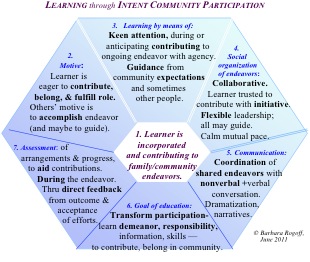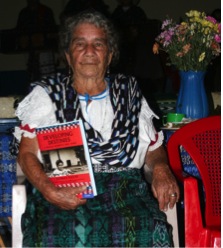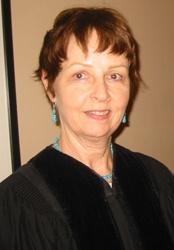I first began working in a Tz’utujiil Mayan town in the highlands of Guatemala, many years ago, interested in understanding how children learned the complex activities of their community. But when I asked mothers “How do you teach your daughters to weave?” they replied, “I don’t teach them to weave, they just learn.” This was a puzzle for me, as I assumed that children don’t learn unless they are taught. (My assumption may have been supported by having spent 19 years in school at that point.)
My research since that 1.5-year period living in San Pedro has circled around trying to answer this question. I have carried out several subsequent investigations in San Pedro and made trips back approximately yearly. In addition, I have engaged in research in collaboration with my students and postdocs in Mexico and among Mexican-heritage families in the US (varying in involvement in Western schooling), as well as Anglo families.
We are interested in understanding a way of learning that seems to be widespread among people with experience with Indigenous-heritage practices of Guatemala and Mexico, which we call learning through intent community participation. Basically, this is learning by observing and pitching in. We use the following prism to describe this way of organizing learning.

My research group and I have carried out research on most of the facets of the prism. We have found that children and other people from Indigenous and Indigenous-heritage families with little Western schooling are more likely (than people with little experience of Indigenous-heritage practices and extensive Western schooling) to be:
• incorporated in a broad range of community activities
• expected and eager to contribute with initiative
• supported in their efforts by others nearby who are engaging in related activities, who allow them initiative and trust their ability to contribute
• attending keenly to events surrounding them, including events that do not directly involve them
• collaborating by blending agendas with others, with initiative, attentively even when not directly involved
• coordinating shared endeavors with articulate nonverbal conversation (in addition to talk)
• guided by nonverbal conversation (in addition to talk) in the context of shared endeavors, as well as by counsel in narrative or dramatic form
• showing consideration (respeto) for the direction of the group endeavor.
For more information:
Research on Intent Community Participation
But here’s a new puzzle: A prominent Mayan midwife reports that she did not learn her spiritual healing practice this way. Instead, she learned by being born to this calling —through divine selection — and through dream visits of ancestor midwives who taught her both the obstetric and the spiritual practices. I wrote about all these ways of learning in my new book:
Rogoff, B. (2011). Developing Destinies: A Mayan Midwife and Town. NY: Oxford.
Available on Amazon (with a discount)
See Photos and paintings on Facebook page for Developing Destinies Book
Proceeds from the book are donated to the Learning Center and other projects in San Pedro.
Developing Destinies builds on an account of this individual and her town to make theoretical progress in understanding how people and their communities simultaneously contribute to individual development and changes and continuities in cultural practices.

Articles about learning through intent community participation:
Rogoff, B., Paradise, R., Mejía Arauz, R., Correa-Chávez, M., & Angelillo, C. (2003). Firsthand learning through intent participation. Annual Review of Psychology, 54, 175-203.
Rogoff, B., Moore, L., Najafi, B., Dexter, A., Correa-Chávez, M., & Solís, J. (2007). Children’s development of cultural repertoires through participation in everyday routines and practices. In J. E. Grusec & P. D. Hastings (Eds.), Handbook of socialization. (pp. 490-515). NY: Guilford.
Paradise, R., & Rogoff, B. (2009). Side by side: Learning through observing and pitching in. Ethos, 37, 102-138.
López, A., Najafi, B., Mejía Arauz, R., & Rogoff, B. (in press). Helping and collaborating as cultural practices. In J. Valsiner (Ed.), The Oxford Handbook of Culture and Psychology. NY: Oxford University Press.

